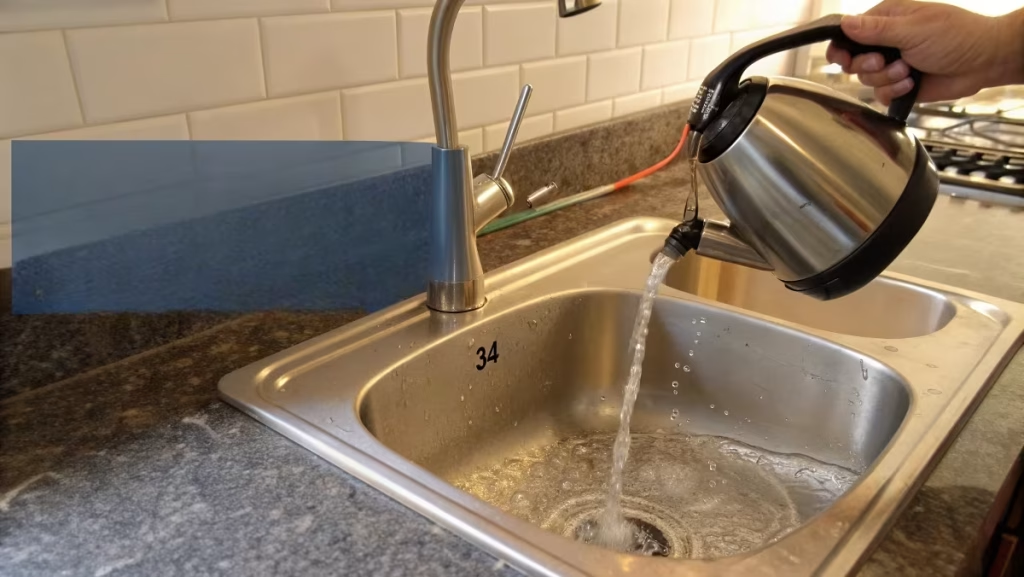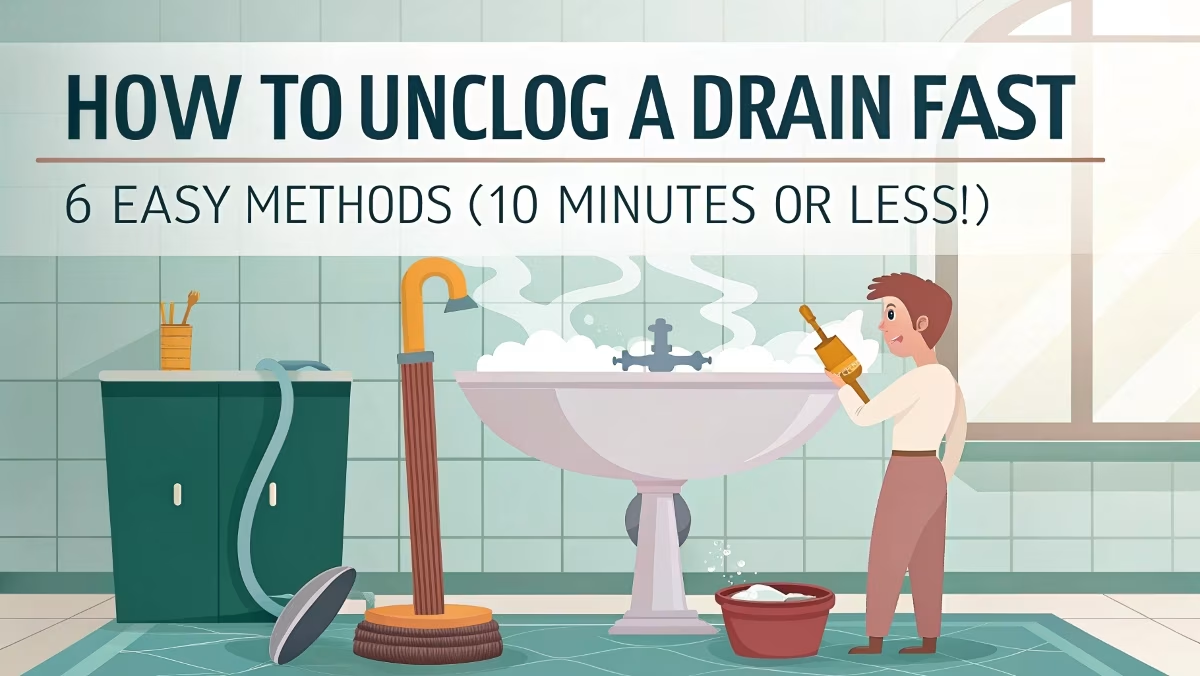A clogged drain is one of the most annoying household problems. Whether it’s a slow-draining kitchen sink, a backed-up shower, or a stubborn bathroom drain, a blockage can disrupt your daily routine. The good news? You don’t always need to call a plumber or spend money on harsh chemicals. With the right techniques, you can clear most clogs in just 10 minutes.
In this detailed guide, I’ll walk you through step-by-step methods to unclog any drain quickly and safely. I’ve included natural solutions, DIY tools, and preventive tips to keep your pipes flowing smoothly.
Why Do Drains Get Clogged? (Common Causes)
Before fixing a clog, it helps to know what’s causing it. Here are the most common culprits:
1. Kitchen Sink Clogs
- Grease & oil – Hardens inside pipes and traps food particles.
- Food scraps – Coffee grounds, eggshells, and starchy foods (pasta, rice) expand and block drains.
- Soap buildup – Combines with grease, creating stubborn blockages.
2. Bathroom Drain Clogs
- Hair – The #1 cause of shower and sink clogs.
- Soap scum – Mixes with minerals in water, forming a sticky residue.
- Toiletries – Cotton swabs, dental floss, and small objects get stuck.
3. Main Sewer Line Clogs
- Tree roots – Can invade underground pipes.
- Flushed items – Wipes, paper towels, and feminine products don’t break down easily.
- Old pipes – Corrosion and pipe damage lead to recurring clogs.
Now, let’s dive into the fastest and most effective ways to unclog a drain.
Method 1: Boiling Water (Best for Grease & Soap Clogs)
Works best for: Kitchen sinks with grease buildup or soap clogs.
Steps:
- Boil 3-4 cups of water (more for larger clogs).
- Slowly pour half down the drain and wait 30 seconds.
- Pour the rest and check if the water drains faster.
- Repeat if needed.

⚠️ Warning: Do not use boiling water on PVC pipes—it can soften and warp them.
Method 2: Baking Soda & Vinegar (Natural Drain Cleaner)
Works best for: Mild to moderate clogs (hair, food, soap scum).
Steps:
- Pour ½ cup baking soda into the drain.
- Add 1 cup white vinegar—it will bubble and fizz.
- Cover the drain (with a plug or cloth) to keep the reaction inside.
- Wait 10 minutes—this breaks down grime and debris.
- Flush with hot water to clear the loosened clog.
🔹 Pro Tip: For extra cleaning power, add ½ cup salt to the mix.
Method 3: Plunger (For Stubborn Blockages)
Works best for: Sinks, showers, and toilets with deep clogs.
Steps:
- Remove standing water (if possible) for better suction.
- Cover overflow holes (in sinks) with a wet rag.
- Place plunger over drain and press firmly to create a seal.
- Pump vigorously 10-15 times—quick, strong plunges work best.
- Check drainage—repeat if needed.
🔹 Pro Tip: Use a cup plunger for sinks and a flange plunger for toilets.
Method 4: Wire Hanger or Drain Snake (For Hair & Debris)
Works best for: Shower drains clogged with hair.
Steps:
- Straighten a wire hanger, leaving a small hook at the end.
- Insert into the drain and twist to catch hair.
- Pull out the clog—you’ll often see a gross hairball!
- Flush with hot water to clear remaining debris.
🔹 For deeper clogs: Use a drain snake (available at hardware stores).
Method 5: Wet/Dry Vacuum (Powerful Suction Method)
Works best for: Deep, hard-to-reach clogs.
Steps:
- Set vacuum to “liquid mode.”
- Seal the drain opening with a wet rag for better suction.
- Turn on the vacuum—it will suck out the clog.
- Check drainage and repeat if necessary.
Method 6: Salt & Baking Soda (Preventive Maintenance)
Keeps drains clear and prevents future clogs.
Steps:
- Mix ½ cup salt + ½ cup baking soda.
- Pour down the drain.
- Let sit for 15 minutes.
- Flush with boiling water.
🔹 Do this monthly to maintain smooth drainage.
When to Call a Plumber?
If none of these methods work, you may have a serious blockage in your main sewer line. Call a professional if:
✔ Water backs up in multiple drains.
✔ You hear gurgling sounds from pipes.
✔ There’s a foul smell even after cleaning.
✔ DIY methods fail repeatedly.
Do you want to know How to open a coconut?
FAQs – How to Unclog a Drain
1. What is the fastest way to unclog a drain?
- Boiling water (for grease clogs).
- Plunger (for deep blockages).
2. Can I use bleach to unclog a drain?
❌ No! Bleach doesn’t dissolve clogs—it only sanitizes and can damage pipes.
3. Why does my drain keep clogging?
- Hair, grease, or debris buildup.
- Old/damaged pipes.
- Lack of regular cleaning.
4. Is Drano safe for pipes?
⚠️ Not long-term! It can corrode pipes—use baking soda + vinegar instead.
5. How do I unclog a shower drain full of hair?
- Use a wire hanger or drain snake.
- Follow up with baking soda + vinegar.
6. Can a clogged drain fix itself?
🔄 Rarely. Most clogs need manual removal or dissolving agents.
7. How often should I clean my drains?
📅 Monthly with baking soda + vinegar to prevent buildup.
Final Thoughts
Unclogging a drain doesn’t have to be difficult. With these simple, fast methods, you can clear most blockages in under 10 minutes. Start with the easiest solution (boiling water) and move to stronger methods if needed.
Regular maintenance (like monthly baking soda treatments) keeps drains flowing smoothly. If all else fails, a professional plumber can handle stubborn clogs.
Got a stubborn clog? Try these methods and let me know what works for you!
💬 Need more help? Drop your questions in the comments!
